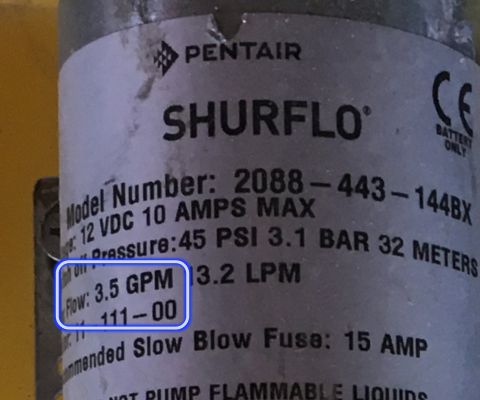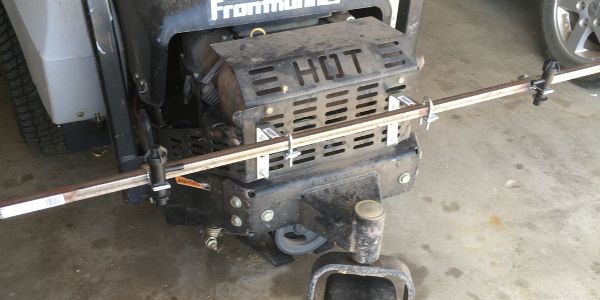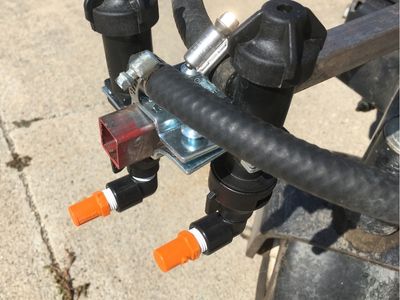A Spot sprayer is a great tool for managing weeds and other pests. Especially around buildings, fencelines, and remote areas. But what if you want to spray a large area like a food plot or a large acreage, a sprayer with a boom is much more efficient. This brings up a good question can you add a boom to a spot sprayer?
Simply put, yes you can add a boom to a spot sprayer. Typically, it is very simple to add a small boom to a spot sprayer. The majority of spot sprayers will work well with small booms with 3 to 7 nozzles, ranging from 5 to 12 ft in coverage. There are a few key things to keep in mind when adding a boom to your spot sprayer including the flow capacity of your sprayer pump, the number of nozzles on the boom, and the width of the spray boom.
If you have been wanting to try and add a boom to your spot spray or stick around we’ll explain how to pick a boom for your current spot sprayer that will meet your needs, how to make sure your pump is large enough, and show you exactly how to connect the boom to your spot sprayer.
Adding a Spray Boom to a Spot Sprayer
Adding a boom to your spot sprayer is a great way to use it for broadcast spring large areas in addition to spot spraying small patches, fence lines, and remote areas. you can typically add a simple boom for a relatively low cost compared to buying a whole other sprayer that already has a boom.
When you add a boom to a spot sprayer it simply requires building or purchasing the boom that you want to add, mounting it onto your vehicle ( this could be a lawn mower, tractor, ATV, etc.), and then connecting it to the outlet of your sprayer pump.
If you are somewhat handy you can build a boom for your spot sprayer without much difficulty. If that sounds like something you might want to tackle be sure to read this post where I break down how to build a simple boom sprayer and show you all the pieces you need.
This is pretty straightforward but before you get started there are some key things you will want to consider before doing so:
- How many gallons per minute will my pump produce?
- How wide of a boom can my mower, ATV, or tractor handle?
- Does my application require a conventional boom or can I use a simpler boomless setup?
- How Will I connect the boom to my vehicle?
- How will I connect the spray boom to my pump?
- Do I need a regulating valve?
This might be way more complicated than you thought, but don’t worry it’s still pretty simple. We just need to make sure we examine these questions before moving forward. So let’s start with the first one.
Is Your Spot Sprayer Pump Large Enough for a Spray Boom?
Spot sprayers are generally all very similar one main way that they differ is in the size of the pump by size I’m talking about the flow rate or gallons per minute that the pump will produce. spot sprayers typically have a 12-volt pump and these types of sprayer pumps typically range from 1 to 5 gallons per minute and about 40 to 60 PSI.
If you are going to add a boom to your spot sprayer, you will now have multiple nozzles instead of having one nozzle on the end of your spray wand. Therefore you need to find out what the gallons per minute capacity of each nozzle, and add up the total. Then make sure that your pump can produce enough liquid per minute to satisfy each nozzle. If your pump is too small the nozzles won’t have enough flow or pressure, and your spray pattern will be inconsistent and ineffective.
It is usually pretty easy to determine the flow rate of your pump. Typically the capacity will be listed on the motor in gallons per minute and sometimes liters per minute. If you look at this picture below you can see that the Shurflo pump I use on my spot sprayer and small yard sprayers will produce 3.5 gallons per minute.

If you can’t locate the GPM on your pump, then you can refer to the chart in my article comparing different spot sprayer models. This will show you the GPM for several different spot sprayer brands.
The other end of the equation is the flow capacity of your spray nozzles. How do you know how many gallons per minute each of your nozzles is going to require? This is also easy to find out.
The flat fan sprayer nozzles are color-coded to indicate their size. By size, I mean the flow rate that they will allow per minute at a given pressure. Spray nozzle sizes and numbers are another topic altogether. I recommend reading this article that will explain in detail how to choose sprayer nozzles for a boom as well as this article which shows you how to tell what size your nozzles are and what the numbers on the nozzles mean.
What Boom Size Can My Vehicle Handle?
Another key thing to consider is what size of boom your vehicle can handle. most spot sprayer pumps are not going to be able to supply enough liquid for a boom that would cover much more than 20 ft. However, this is not the only thing to consider. Some booms are made stronger than others and they are much heavier. For example, a heavy steel boom that’s 20 feet wide might be way too heavy for a small lawn mower.
Also, any hole or bump you go over can cause the end of your boom to dip down and potentially come into contact with the ground. So if you are using again a lawn mower or an ATV, you have to take this into account. The wider the boom the more the possibility for issues and instability.
Obstacles are another thing to take into account. There is no point in having a 20-ft wide boom if you have lots of trees, buildings, rocks, and other things that you need to avoid. If this is your situation a 10-ft wide boom or boomless sprayer, might end up being more efficient. With the smaller boom, you don’t have to work so hard to avoid all these obstacles.
Does My Application Require a Conventional Boom or Can I Use a Boomless Setup?
This brings up the next question: do you need a conventional boom? If you are not familiar, there are two basic types of sprayer booms. The conventional boom, witch is a piece of pipe or bar with multiple nozzles evenly spaced across it. This is what most people are likely thinking of when you say sprayer boom.
The other option is a boomless setup. This eliminates the need for the boom pipe. A boomless sprayer uses two nozzles mounted right behind your sprayer and each one sprays out in a wide pattern covering a similar amount of ground as a wide conventional boom.
Boomless Sprayer Demo Video:
There are many advantages to these types of spray booms. They are easier to make, they are lower cost, and easier to avoid obstacles. However, they produce a coarser droplet that is not suitable for all types of herbicides and pesticides. If you are looking for more guidance, check out this article on whether you should use a traditional boom or a boomless sprayer.
How to Connect and Mount a Boom with a Spot Sprayer
We can answer the rest of these questions in this section. We will look closer at the specifics of mounting the boom to your vehicle as well as the plumbing side of things. Meaning how are we going to get liquid from the pump to your spray boom.
First, we need to consider how you’re going to mount the boom. This is going to be done differently depending on what type of vehicle you are using to spray. If you’re going to purchase a boom to add to the spot sprayer, you can typically find one that is made to be mounted on an ATV or UTV pretty easily. Otherwise, they are fairly universal and will require some modifications to make it work for your scenario.
Now, because there are so many different possibilities when it comes to mounting the boom we won’t be able to discuss all those options. But I will show you what I have personally done to convert my spot sprayer into a boom sprayer.
Mounting a Spray boom on a Lawn Mower
I’ve used two different methods, one is mounting a sprayer boom setup directly onto my zero-turn mower the other is mounting a small boom onto the back of a wagon. First, let’s look at mounting it on the mower.
Conventional Boom Mounting
In my case, I was able to get some brackets attached to a muffler guard without drilling any new holes in metal. This won’t work for everyone but if you have a similar mower, I would suggest reading this guide where I show how to mount this boom on a zero-turn mower.

Here are the parts that I used:
- ¾ inch square steel tube
- Nozzle bodies
- Nozzle body mounting clamps (for mounting nozzle body on the boom)
Boomless Setup on Zero-Turn Mower
Here are the main components you need for the boomless setup:
- Boomless nozzles: Need both “left hand” and “right hand”. *Note that you may need a different size depending on your desired rate. Read more here.
- Nozzle bodies
For a more detailed look, read this guide on everything you need to build a boomless sprayer.

Mounting a Boom on a Small Wagon
Finally, here is the boom or a small trailer sprayer. The boom itself was made using the same components as the zero-turn mower boom. For info on building the full sprayer check out this DIY sprayer build.

How to Connect a Boom to Your 12-volt Spot Sprayer Pump
Now for the most important part, connecting the boom to your sprayer so you can actually get liquid to the spray nozzles! There is not one way to do this but there are some important things to remember:
- Use adequate hose size
- Instal valves to direct liquid
- Use UV and chemical-resistant hose
Don’t use 1/4 inch inside diameter hose. This may restrict your sprayer’s output. Stick with 3/8 or larger. For a small boom, 3/8 will be fine. The hose you use to connect your pump the the spray boom should be EPDM rubber hose. This type of hose is both UV and chemical-resistant. It won’t crack or get hard like some of the garden hoses or nylon braided hoses.
As for installing valves. You will want to be able to shut the boom off if you are just going to use your hand wand. I recommend installing a small ball valve in a “tee” fitting. This will give you control over where the liquid goes.
This video shows how I installed valves to control my spot sprayer boom:
For more details, you can find a full plumbing guide in this article about building a DIY sprayer.
Does Your Spot Sprayer Need a Regulating Valve Before Adding a Boom?
You might ask, what does a regulating valve have to do with adding a boom to my spot sprayer? Well, most spot sprayers do come with a regulating valve but some do not. The regulating valve helps maintain consistent pressure so that your sprayer pump does not cycle on and off rapidly.
This is needed because most 12-volt pumps on spot sprayers have a pressure switch so that they shut off when you stop pulling the trigger on the sprayer wand.
It is possible, that you have been using your spot sprayer without a regulating valve and have had no issues. However, when you add a boom to your sprayer there are many more nozzles and the operating pressure of the system is going to be different. If this pressure is outside of the range of the pressure switch that is on the pump, then it will cycle on and off. For more information read this article about why 12-volt pumps cycle on and off and how to stop it.
If you have a regulating valve then you are good to go, but if you do not, be sure to read this article that fully explains how to add a regulating valve to your sprayer.

